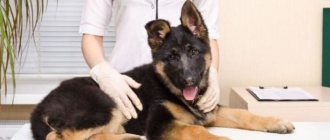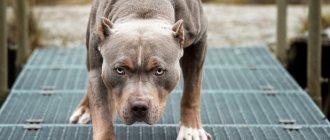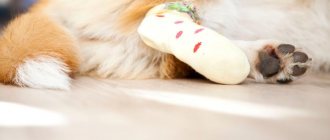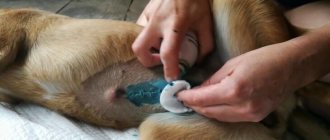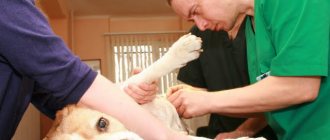Quite often, owners are faced with the problem of lameness in their dogs. The causes of the disease can be very diverse, for example, injury or joint disease. Lameness is a partial or complete loss of mobility that can affect one or both legs. The symptom is detected immediately, as the dog’s gait changes, which is expressed in the asymmetry of the pet’s movements. Lameness itself is not a disease. It is rather a symptom indicating some other problem.
Lameness is a sign of internal impairment or external damage
Possible causes of lameness in dogs
Factors that provoke lameness can be divided into two groups:
- External.
- Internal.
The first category includes:
- Injuries. Moreover, they often go unnoticed - bruises, dislocations, closed fractures, a bite from another animal. The dog limps especially noticeably after lying down or sleeping.
- Bite of a stinging insect - bee, wasp, bumblebee. Also, a dog's paw can become a target for attack by ticks and other ectoparasites. Less commonly, the cause of lameness may be the bite of a snake, including a non-venomous one.
- Broken claw. Such injuries are characterized by changes in gait and bleeding.
- Splinter. Dogs love to explore the territory, so they often stumble upon dangerous objects. Especially when it comes to suburban areas. Typically the splinter penetrates the pad or area between the toes.
- Uncomfortable clothing that restricts movement.
- Uncomfortable position during a long sleep - the pet can simply lie down with its front or back paw.
The group of internal causes includes physiological disorders:
- Rheumatoid arthritis.
- Crick.
- Dysplasia of the hip or knee joint. This is a genetic disorder that can cause muscle atrophy.
- Tendon rupture. The flexor muscles are most often affected. If left untreated, chronic inflammation develops and fibrous tissue forms that connects the tendons. A scar appears, causing the tendons to shorten and movement to become limited. With this diagnosis, the pet rests on the phalanges of the fingers, and not on the pads of the paws.
- Arthrosis. Large dogs are at risk because their joints experience increased stress, especially during puppyhood and in old age. In addition, males suffer from arthritis more often than females.
- Perthes disease. The head of the femur dies due to disruption of its nutrition.
- An unsuccessful injection can damage the sciatic nerve.
- Intervertebral disc disease. Dogs at risk include Welsh Corgis, Beagles, Dachshunds, Bulldogs, Poodles, Shih Tzus, and Pekingese.
- Wobbler syndrome.
- Wedge-shaped vertebrae syndrome.
- Fibrous-cartilaginous embolism.
- Spondymyelopathy.
- Pathologies of the peripheral nervous system (for example, degenerative myelopathy).
On a note. If neurological dysfunction is present, the dog may shake. Also, slight tremors can be a response to pain and weakness.
Rheumatoid arthritis in a dog
Joint dislocations and muscle strains
Muscle strain can occur when your pet falls or jumps. The most susceptible to this disease are dachshunds, pugs and other breeds with short legs. Also at risk are animals with a fragile constitution - miniature dogs (Chihuahua, Spitz, Yorkie, Chinese Crested). Overly active animals can suffer as a result of games and training.
Dislocation can occur either due to injury or due to genetic abnormalities. The latter include dysplasia of the hip or knee joint. Predisposing factors for the development of the disease are:
- poor nutrition;
- bad ecology;
- imbalance of physical activity (lack or excess).
On a note . Hip dysplasia is common in large breeds, while luxating patella usually occurs in small dogs.
Sprain in a dog
Consequences of injection and other manipulations
The causes of lameness in this case are associated with pinching or damage to the nerve at the time of injection. In addition, if we talk about antibiotics, such injections are very painful - so much so that they can cause short-term lameness in the pet.
Benign and malignant neoplasms
Benign tumors can be caused by the following reasons:
- fungal infections (skin itches, gets wet);
- allergy;
- kidney or heart disease;
- advanced dermatitis;
- burn, including chemical burn;
- ingrown claw.
Malignant tumors most often appear due to age-related changes.
Rheumatoid arthritis
It is an inflammation inside a joint. It can occur against the background of age-related changes, as well as with weakened immunity. Upon careful examination, you may notice slight swelling in the joint area, but if the internal joint is affected, the swelling will not be visible.
Other pathologies that cause lameness
Other pathological reasons that can cause lameness in a dog include:
- vitamin deficiency;
- dry pads;
- frostbite;
- diabetes;
- Vitamin deficiency can cause nutritional hyperparathyroidism in puppies.
To prevent your dog from breaking his nails, they need to be trimmed regularly.
The appearance of permanent lameness
Sometimes a dog suddenly begins to limp, and then the lameness also disappears imperceptibly. This is a signal of bone or joint disease. Sometimes this is how a disease of internal organs manifests itself. The dog could also bruise or bruise its paw . The cause can be any ailment of the pet. The most common are:
- Arthrosis or arthritis . The disease cannot be completely cured. However, you can maintain your four-legged friend's joint throughout his life. Lameness will appear after sleep or prolonged periods of rest. As soon as the dog warms up its muscles, the lameness will immediately go away.
- Spinal disease . If your dog has previously had a spinal injury or is diagnosed with a spinal hernia, you should immediately seek help from a veterinarian. This can prevent further paralysis of the animal.
- Malignant neoplasms . Osteosarcoma is a common cancerous tumor. The animal needs to be x-rayed. Treatment is best carried out under the supervision of an experienced specialist.
- Heredity . This pathology cannot be treated. To avoid the disease in other animals, you should not breed offspring from a sick dog.
- Dysplasia . A disease that causes lameness. Breeds such as Rottweiler, Labrador, Shepherd, Alabai, and Retriever often suffer from it. These breeds are large and therefore prone to dysplasia.
How to correctly determine the cause of lameness
Regardless of the degree of lameness, the cause is determined by careful examination of the problem limb. If you cannot identify the disease on your own, you should contact a veterinary clinic. You will also have to go to the hospital if a serious pathology is detected.
On a note. When examining the paw, you must carefully monitor the animal's reaction.
The following symptoms indicate the severity of the problem:
- the dog tries to tuck his paw when walking;
- cannot fully lean on a limb;
- decreased activity;
- The dog has stopped jumping and cannot go up or down stairs.
In this case, the paw may not hurt at all.
At the clinic, the doctor carefully examines the dog, collects anamnesis and, based on the results, prescribes a surgical and neurological examination. Further, X-rays, MRI, ultrasound, computed tomography, arthroscopy may be required.
Features of home diagnostics
If the dog’s previously light and springy gait suddenly changes for the worse, it’s easy to notice. There is an effective way to check the condition of the pet: wet the surface and walk the dog along it, then analyze the step by measuring the distance between the tracks. It is also necessary to pay attention to the position of the paws. Signs of problems indicate:
- short step;
- extension of the limb or rotation inward;
- if the leg is sick, then the mark will be weak.
For further diagnosis, the dog is taken to the veterinary clinic.
Appearance of instant lameness
It is much worse if there are no visible lesions.
In this case, a bone or joint in the leg may be damaged. Such problems may include a dislocation or fracture. If unsuccessfully jumping from a height, the animal may dislocate its paw. In this case, swelling of the limb will appear. If a dog twists its paw, the owner can alleviate its condition. The pet will try not to step on the injured limb. Applying ice will help relieve inflammation.
A fracture can most often be caused by active movement: while an animal is playing, or when sliding on a tile. The limb will take on a different shape and severe swelling will appear. The animal will need help. It is necessary to fix the paw. In any case, you need to immediately go to the veterinary hospital.
How to prepare for a visit to the veterinary clinic
The first thing to do is to collect as much information as possible about the pet’s condition:
- the dog presses its back paw strongly or weakly;
- does she experience pain when palpating the problem area;
- how much the limb hurts while walking (whether the pet whines, shows aggression, etc.);
- what were the previous events (fights, walks in abandoned areas, vaccination, etc.) - the answer to this question will help to understand what could presumably have caused the lameness.
On a note! Before examination, it is recommended to put a muzzle on the dog.
Examination of a sore paw
Causes
- A dog can be injured by jumping too hard, running too much while playing, or swimming in a pond for too long. Perhaps the lameness in this case was due to strong and prolonged muscle tension, and there is nothing to worry about. But sometimes these simple actions lead to fractures, dislocations and sprains in overly active dogs. Observe the dog for several days. In the absence of pain symptoms (the dog does not whine) or loss of appetite, the disease will go away in a couple of days.
- Prolonged lameness may be caused by hip dysplasia or arthritis. These are serious diseases that require special treatment in a veterinary clinic.
- If a dog cuts a paw or damages a claw, this can also cause lameness.
- Burns (chemical and thermal) can be very painful, which will certainly affect the dog's movements.
- If the dog is limping, be careful when examining the sore paw: you may hurt, and your pet may bite you, not wanting to harm you.
Preventive actions
The following steps will help you avoid lameness:
- Proper animal care.
- Balanced diet.
- Regular examination of the limbs (at least once a week). Paws must be examined after going to the forest or mountains.
- In winter, small dogs should wear special shoes.
- Timely trimming of nails.
- Washing paws with soap after every walk, removing dirt from the spaces between the toes.
- Trimming the fur between the fingers.
- Tracking the degree and complexity of physical activity.
- Compliance with breed breeding rules (closely related unions are excluded, animals with hereditary diseases should not participate in breeding).
- When walking, avoid dangerous places (where there are a lot of stones, glass, branches, etc.).
- Minimize contact with other animals.
If lameness is detected in a pet, the problem should not be ignored under any circumstances. It is better to show the dog to a veterinarian and make sure that there is no cause for concern, or if a serious pathology is detected, start treatment on time.
Labrador limping on his hind leg
Although hind leg lameness has similar, common causes in most dogs, hind leg lameness in Labradors has its own characteristics. These features include diseases that have a breed predisposition. Each dog breed can have its own prevailing trends in the frequency of detection of one or another pathology, which gives a clinical picture of lameness.
So what are the most common causes of hind leg lameness in a Labrador? In the list below, we will not consider short-term lameness associated with acute and minor sprains or bruises, or paresis of the foot. This can happen to all dogs that lead an active lifestyle.
So, lameness on the hind limb in a Labrador retriever lasting two or more days can give (the list is ranked by frequency of occurrence in the practice of a veterinarian, the higher, the more often):
- Hind leg lameness in a Labrador puppy is most often associated with hip dysplasia. Lameness can be constant, but more often it intensifies after sleep or rest and decreases or even disappears completely during a walk;
- Hind leg lameness in an adult Labrador is most often associated with a torn anterior cruciate ligament of the knee. Moreover, lameness does not necessarily appear suddenly, immediately after a rupture or tear of the ligament. The process of “traumatization” can be repeated and extended over time (weeks and even months);
- Lameness on the hind leg in an adult Labrador (usually over 6 years old) can be neurological in nature. Thus, with compression diseases of the spinal cord and irritation of the nerve fibers supplying the left or right hind limb, or even with direct compression of the spinal root, the dog may feel pain and limp on one of the hind legs, while when examining the limb itself, it may not be detected no diseases. In such situations, it is necessary to check the condition of the sciatic nerve, conduct a test for lumbosacral syndrome and, possibly, perform an MRI of the lumbosacral region to accurately identify the disorder;
- Hind leg lameness in a Labrador of any age (but much more common in a puppy) can be due to instability of the stifle. Determined by inspection in combination with radiography of the joint;
- Lameness in a Labrador puppy on the hind limb may be associated with dysplasia of the ankle-talar joint and dissecting osteoarthritis. This pathology is manifested by deformation of the contours of the joint, sometimes the appearance of edema (synovitis) to the left and right of the heel bone. This disease can go unnoticed in puppyhood and manifest itself much later in the form of advanced deforming osteoarthritis;
- Lameness in a Labrador under 1.5 years of age in the hind limb can be caused by dissecting osteoarthritis of the knee joint. This disease in dogs is often confused with a cruciate ligament rupture, but the causes and treatment are completely different.
- Less common are neoplasms of bones and soft tissues of the hind limb.
Despite the relative ease of determining the source of lameness, in some cases finding the cause is difficult and requires a specialized neurological and orthopedic examination.


